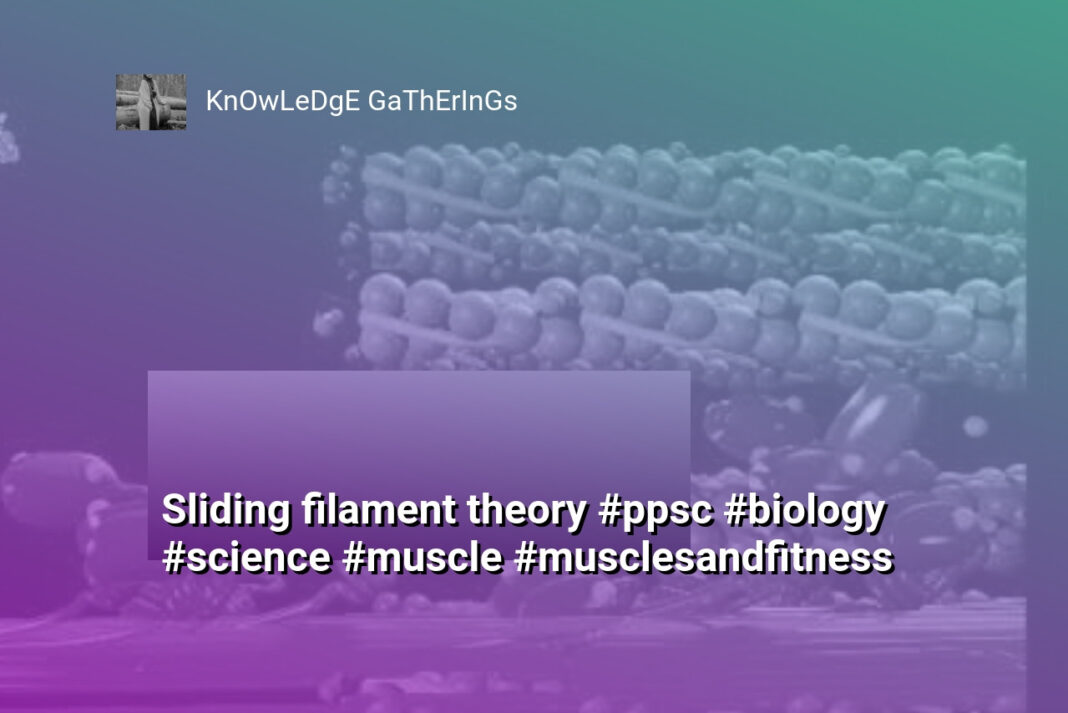The Bottom Line:
- The sliding filament theory explains the mechanism of muscle contraction at the cellular level, where muscle proteins slide past each other to generate movement.
- Skeletal muscles are composed of muscle fibers called fasciculi, which are further divided into individual muscle fibers covered by connective tissue called the endomysium.
- The muscle fiber contains hundreds to thousands of myofibrils, which are made up of smaller structures called sarcomeres, consisting of thick filaments (myosin) and thin filaments (actin).
- During muscle contraction, the thin filaments (actin) slide over the thick filaments (myosin) in a process called the cross-bridge cycling, which is triggered by a nerve signal and the release of calcium.
- The contraction cycle continues until the nerve signal stops, causing the muscle to relax and the sarcomeres to return to their original length.
The Muscle Structure: Layers and Connective Tissues
Layers of Muscle Tissue
The skeletal muscle is composed of multiple layers of connective tissues that provide structure, support, and protection. The outermost layer is called the epimysium, which surrounds the entire muscle. Within the epimysium, there are bundles of muscle fibers called fasciculi, each of which is surrounded by a layer of connective tissue called the perimysium.
Muscle Fibers and Myofibrils
Each fasciculus contains numerous individual muscle fibers, which are the basic contractile units of the muscle. These muscle fibers are surrounded by a layer of connective tissue called the endomysium, which provides insulation and support for the fibers. Inside each muscle fiber, there are hundreds to thousands of smaller units called myofibrils, which are the fundamental contractile elements responsible for muscle contraction.
Sarcomeres and Sliding Filaments
The myofibrils are composed of repeating units called sarcomeres, which are the basic functional units of muscle contraction. Within each sarcomere, there are two main types of filaments: the thick filaments, composed of the protein myosin, and the thin filaments, composed of the protein actin. The sliding of these filaments past each other, driven by the interaction between myosin and actin, is the basis of the sliding filament theory of muscle contraction.
The sarcomere is further divided into distinct regions, including the A-band, which contains the entire thick filament, the I-band, which contains only the thin filament, the Z-line, where the thin filaments from adjacent sarcomeres are anchored, and the H-zone, which is the region between the Z-lines that contains only the thick filaments.
During muscle contraction, the thin filaments slide inward towards the center of the sarcomere, causing the sarcomere to shorten and the muscle fiber to contract. This process is driven by the formation of cross-bridges between the myosin heads and the actin filaments, which pull the thin filaments towards the center of the sarcomere.
The Sarcomere: The Fundamental Unit of Muscle Contraction
The Sarcomere: The Fundamental Unit of Muscle Contraction
The sarcomere is the basic structural and functional unit of muscle contraction, responsible for the sliding filament mechanism that generates force and movement. Within the muscle fiber, the sarcomere is the repeating unit that makes up the myofibril, which is the contractile element of the muscle cell.
The Anatomy of the Sarcomere
The sarcomere is composed of two main types of filaments: the thick filaments, made up of the protein myosin, and the thin filaments, made up of the protein actin. These filaments are arranged in a highly organized manner, with the thick filaments located in the center of the sarcomere and the thin filaments extending from the Z-lines on either side.
The sarcomere is divided into several distinct regions:
– The A-band: This region contains the entire thick filament and the overlapping portion of the thin filaments.
– The I-band: This region contains only the thin filaments, with no overlap with the thick filaments.
– The H-zone: This is the central region of the A-band, where the thick filaments are not overlapped by the thin filaments.
– The M-line: This is the central region of the sarcomere, where the thick filaments are cross-linked and anchored.
– The Z-line: This is the boundary between adjacent sarcomeres, where the thin filaments are anchored.
The Sliding Filament Mechanism
The sliding filament theory explains how the sarcomere contracts to generate force and movement. When a muscle is stimulated, calcium is released from the sarcoplasmic reticulum, which triggers a series of events that lead to the sliding of the thin filaments over the thick filaments.
The myosin heads on the thick filaments bind to the actin binding sites on the thin filaments, forming cross-bridges. As the myosin heads undergo a conformational change, they pull the thin filaments towards the center of the sarcomere, shortening the overall length of the sarcomere. This process is driven by the hydrolysis of ATP, which provides the energy for the myosin heads to detach from the actin and then reattach in a new position, continuing the sliding motion.
The repeated formation and breaking of these cross-bridges, along with the sliding of the filaments, is the fundamental mechanism by which muscle contraction occurs at the cellular level, ultimately leading to the generation of force and movement in the whole muscle.
The Sliding Filament Mechanism: Actin and Myosin Interaction
The Role of Actin and Myosin in Muscle Contraction
The sliding filament mechanism is the fundamental process that underlies muscle contraction at the cellular level. This mechanism involves the interaction between two key muscle proteins: actin and myosin.
Actin Filaments and Myosin Heads
The sarcomere, the basic functional unit of a muscle fiber, contains thin actin filaments and thick myosin filaments. The actin filaments are anchored at the Z-lines, while the myosin filaments are centered at the M-line. During muscle contraction, the thin actin filaments slide past the thick myosin filaments, causing the sarcomere to shorten and the muscle to contract.
The Crossbridge Cycle
The interaction between actin and myosin is driven by a cyclic process known as the crossbridge cycle. This cycle is initiated when a nerve signal reaches the muscle cell, causing the release of calcium ions. The calcium ions trigger a conformational change in the tropomyosin molecule, exposing the binding sites on the actin filaments.
The myosin heads then bind to the exposed actin binding sites, forming a crossbridge. As inorganic phosphate is released, the myosin heads undergo a power stroke, pulling the actin filaments closer to the center of the sarcomere. This contraction is driven by the energy released from the hydrolysis of ATP, which binds to the myosin heads and causes them to detach from the actin filaments.
The cycle then repeats, with the myosin heads binding to new actin binding sites, pulling the filaments closer together, and then detaching as a new ATP molecule binds. This continuous cycle of crossbridge formation, power stroke, and crossbridge detachment is the fundamental mechanism that drives muscle contraction.
The sliding filament theory, with its detailed understanding of the actin-myosin interaction, has provided a comprehensive explanation for the way muscles generate force and movement at the cellular level. This knowledge has been crucial in advancing our understanding of muscle physiology and has had far-reaching implications in fields such as exercise science, rehabilitation, and the development of therapeutic interventions for muscle-related disorders.
The Contraction Cycle: How Muscle Fibers Generate Force
The Contraction Cycle: Muscle Fiber Force Generation
The contraction of skeletal muscles is a complex process that involves the coordinated movement of various proteins within the muscle fibers. The sliding filament theory provides a detailed explanation of how this process occurs at the cellular level.
Calcium Signaling and Tropomyosin Shift
When a nerve signal reaches the muscle cell, it triggers the release of calcium ions (Ca2+) from the sarcoplasmic reticulum. This influx of calcium causes a conformational change in the tropomyosin molecule, which shifts its position to expose the binding sites on the actin proteins. This crucial step allows the myosin heads to interact with the actin filaments, initiating the contraction cycle.
Crossbridge Formation and Power Stroke
With the binding sites exposed, the myosin heads can now attach to the actin proteins, forming a crossbridge. As inorganic phosphate is released, the myosin heads undergo a power stroke, pulling the thin actin filaments closer to the center of the sarcomere (the basic contractile unit of a muscle fiber). This sliding motion of the actin filaments over the myosin heads is the driving force behind muscle contraction.
The power stroke is fueled by the hydrolysis of adenosine triphosphate (ATP) molecules. When a new ATP molecule binds to the myosin head, it causes the crossbridge to detach, allowing the myosin head to return to its original position, ready to repeat the cycle. This cyclic attachment and detachment of the myosin heads to the actin filaments, known as the cross-bridge cycle, is the fundamental mechanism by which muscles generate force and produce movement.
The contraction cycle continues as long as the nerve signal persists, with the repeated attachment and detachment of the myosin heads to the actin filaments. This coordinated and rhythmic movement of the muscle proteins is what allows skeletal muscles to contract and generate the necessary force for various physical activities.
Calcium Regulation and the Tropomyosin Shift
Calcium Regulation and the Tropomyosin Shift
The sliding filament theory of muscle contraction explains how the interaction between the thin actin filaments and the thick myosin filaments leads to the shortening of the sarcomere, the basic contractile unit of a muscle fiber. This process is tightly regulated by the presence of calcium ions (Ca2+) within the muscle cell.
When a nerve impulse reaches the muscle cell, it triggers the release of calcium ions from the sarcoplasmic reticulum, a specialized organelle that stores calcium. The influx of calcium ions into the cytoplasm of the muscle cell is a crucial step in the activation of the contractile apparatus.
The Role of Tropomyosin
In the resting state, the thin actin filaments are covered by a protein called tropomyosin, which blocks the myosin-binding sites on the actin molecules. This prevents the myosin heads from interacting with the actin, and the muscle remains relaxed.
When calcium ions are released into the cytoplasm, they bind to a protein called troponin, which is associated with the tropomyosin molecule. This binding causes a conformational change in the tropomyosin, shifting it away from the myosin-binding sites on the actin filaments. This exposes the binding sites, allowing the myosin heads to interact with the actin and initiate the cross-bridge formation and the sliding of the filaments.
The Crossbridge Cycle
The binding of the myosin heads to the exposed actin-binding sites forms a crossbridge. This crossbridge is stabilized by the release of inorganic phosphate (Pi) from the myosin head. The subsequent release of ADP (adenosine diphosphate) from the myosin head triggers the power stroke, where the myosin head rotates and pulls the actin filament towards the center of the sarcomere, resulting in the shortening of the muscle fiber.
The crossbridge cycle continues as long as calcium ions are present in the cytoplasm and the nerve impulse persists. The binding and release of ATP (adenosine triphosphate) to the myosin head allows the crossbridge to detach and reform, enabling the repeated contraction and relaxation of the muscle fiber.
This intricate interplay between calcium regulation, tropomyosin, and the crossbridge cycle is the foundation of the sliding filament theory, which explains how muscles generate the force necessary for movement and other physiological functions.





